Cover photo: The ejido Paraíso Nuevo is divided by train tracks. The Maya Train has augmented the division of the community. Photo: Santiago Navarro F.
Perla Rubí Garduza Pablo, a housewife living in the ejido Paraíso Nuevo, Campeche, sighs from the question: What do you think about the president declaring that he wasn’t going to knock down any trees? The sky clouded over, anticipating the rain. She responded, “It is a lie! They have damaged our flora, our fauna, and our life,” clearly upset about the construction of the Maya Train in her community.
The devastation witnessed in the ejido Paraíso Nuevo is taking place in other territories as well. According to an analysis of satellite images carried out by CartoCrítica, as of June 2023, 6,659 hectares have been deforested in the Yucatan Peninsula to make way for the construction of the Maya Train. CartoCrítica emphasizes that of those 6,659 hectares, 5,769 of them were deforested ignoring environmental legislation. Changes in land use were not authorized by the Secretariat of Environment and Natural Resources (SEMARNAT).
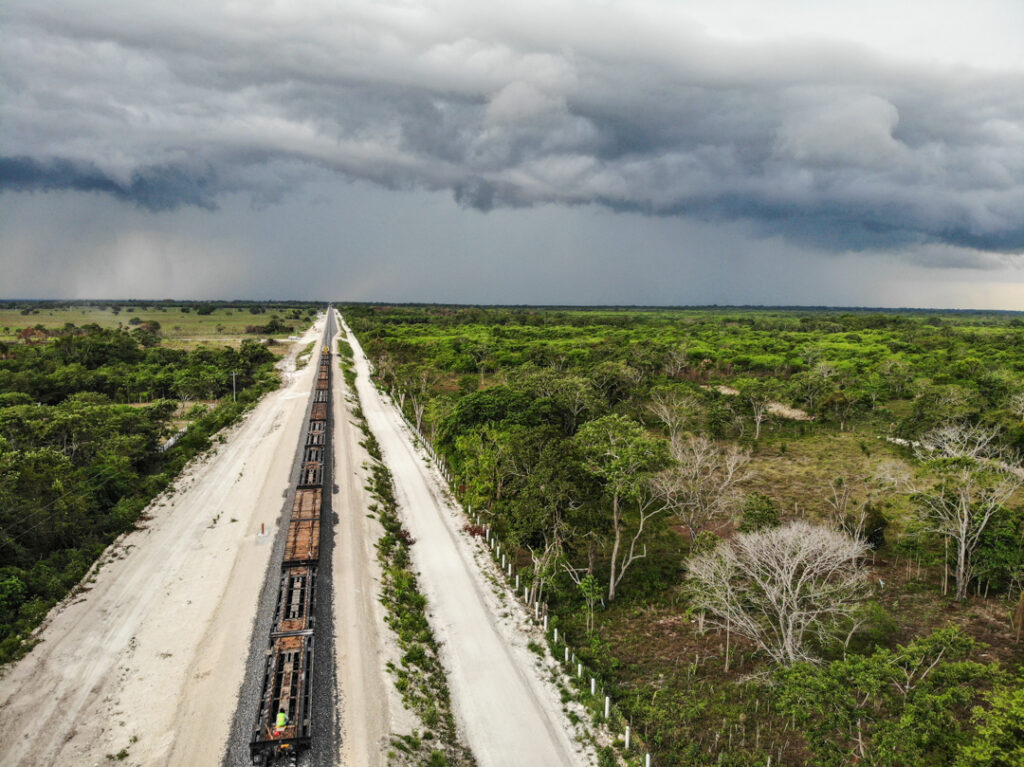
Rubí complains that promises from government officials to provide benefits to the population in exchange for the project were not fulfilled. She says that the damages caused by the megaproject are palpable in the everyday life of the community in southern Campeche.
A team from Avispa Midia visited the ejido Paraíso Nuevo, where Section 1 of the Maya Train is being built. The residents say that the negative consequences of the megaproject are not something on the horizon, but are already present, and have been for three years since construction began during the Covid-19 pandemic.
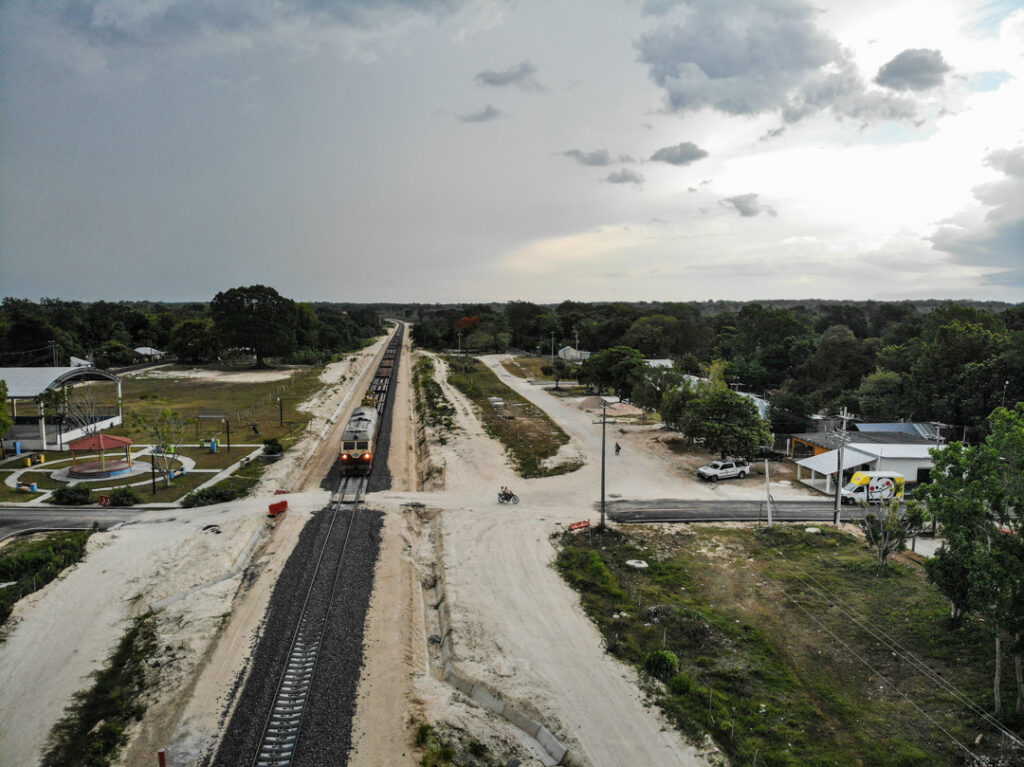
Joel Jiménez is one of the 300 inhabitants of this ejido, located 14 kilometers from the city of Candelaria, where one of the train’s stations is being built. A leather worker and evangelical pastor, he was one of the first to begin denouncing the damage being caused by the construction of the train lines.
“At that time, they were throwing limestone powder. Everyone got sick with respiratory problems. There were elderly folks who were taken to the emergency room. The Covid pandemic combined with the construction of the train lines; those were times when we didn’t even know what to do,” Rubí adds.
“According to what we were told, the project would bring much progress,” the pastor recalls. However, rather than progress, the impact on the community and environment has been severe, including the loss of thousands of trees, the disappearance of fauna, as well as deception from false job offers for youth in the community.
Furthermore, the community has been militarized. Members of the Mexican army and national guard are in the community, constantly guarding the train lines. “They are here in our community, they monitor that nobody goes onto the tracks,” says the pastor, who explains that the armed forces have remained in the community since January of 2023 after the violent eviction of inhabitants who had set up a blockade at the construction site.

Division
For inhabitants of Paraíso Nuevo, the principal problem is that the community is divided by the train lines. “They divided us,” says Rubí, but her description is not limited to the social question. The Maya Train enhanced the separation of the community, making movement within the community difficult for inhabitants who were accustomed to walking across where the train lines now exist, to go to school, the clinic, or to obtain basic goods.

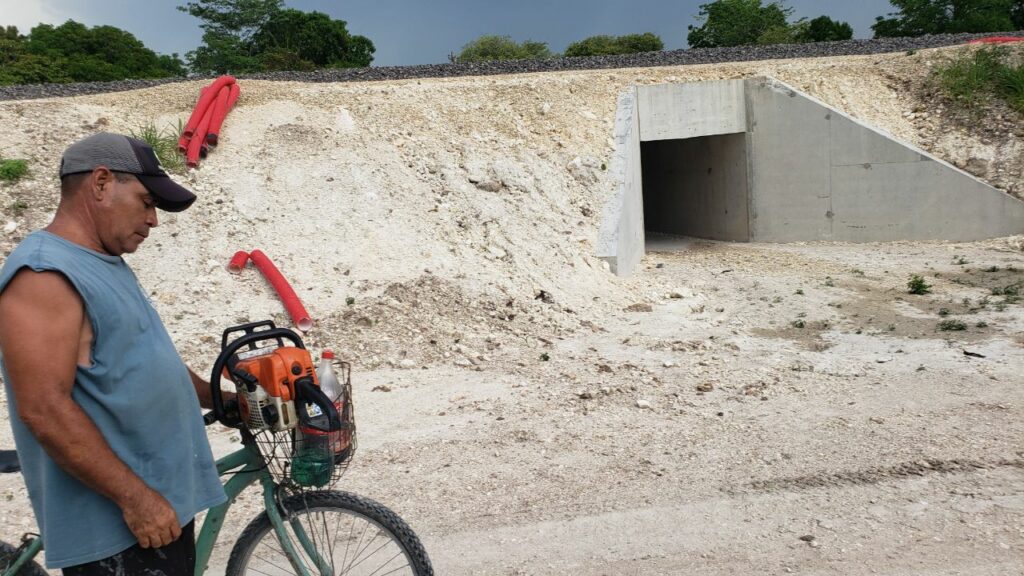
While the Maya Train will be protected by an embankment, according to inhabitants of Paraíso Nuevo, the different crossings of the train lines that already existed will be blocked off by a fence once the train begins operation.
For this reason, inhabitants of the community demanded the construction of three bridges for easy crossing of everyone in the community, because depending on their location, many will have to travel up to a kilometer along the tracks just to cross. In spite of the initial promises, only one elevated bridge was constructed. It is almost three meters high, and will also be used by automobiles, ignoring the demands of the community. “Here we have people in wheelchairs, elderly, children. The president is not paying attention to the harm being caused to our community,” sustains Rubí.
The pastor mentions that on repeated occasions, the community solicited the construction of the bridges for their own safety. To justify the decision not to construct the bridges, “An engineer dared to tell me, ‘it is because of the money. A bridge for the whole road costs 50 million pesos, and what we are doing will only cost 20 million.’ In other words, they want to save 30 million pesos at the expense of the people,” claims Jiménez.
Strategies
According to Rubí, there were several strategies used by the government to impose the megaproject. One of them, repeated in various places like Candelaria, Campeche and Bacalar, Quintana Roo, was to negotiate the authorization of the construction exclusively with ejido members, in spite of their presence being almost nil in Paraíso Nuevo.
“There are only five ejido members that live here. The majority live in Candelaria, in Ciudad de Carmen, in Campeche. That was the argument made by the community. The ejido members were paid although they had no reason to be. The project did not harm them,” contextualized Rubí, referring to how the ejido members received a compensation payment for approval of the project’s construction.
She says that community members were surprised and upset when heavy machinery arrived to begin construction after an agreement was reached between the National Fund for Tourism Development (FONATUR) and ejido members. The community’s first reaction was to send letters to local authorities demanding benefits in the community in exchange for approval of the project.
The pastor points out that the community made clear to government officials and authorities their disagreement with the project, because of the harm caused by the restriction of mobility inside the community. They even sent a commission of community members to Mexico City to demand attention to their demands, but there was no response. For this reason, the population mobilized installing a blockade and halting construction.
Section 1
The construction work on Section 1 of the Maya Train, a contract worth more than $13,394,000,000 pesos, is being carried out by Consorcio LAMAT Tramo 1, a business group that includes Mota-Engil Mexico, China Communications Construction Company LTD, Grupo Cosh, Eyasa and Gavil Ingeniería.

The Mexican subsidiary of the Portuguese company, Mota-Engil, has been repeatedly accused of anomalies in its contracts with the federal government, particularly with the Secretariat of Infrastructure, Communications, and Transportation during the administration of Enrique Peña Nieto. The Superior Auditor of the Federation reported irregularities in highway projects; unforeseen expenses in Guanajuato, undue payments in Colima, as well as unjustified expenses in the section Coatzacoalcos-Villahermosa in Tabasco.
In spite of this history, the company has secured other contracts during the current administration of Andrés Manuel López Obrador (AMLO). In addition to the contract with FONATUR, it has secured contacts with the National Bank of Public Works and Services, as well as with the Secretariat of the Navy. The latter agency awarded it a contract for more than $11,000,000,000 pesos to rehabilitate 310 kilometers of train lines between Coatzacoalcos and Palenque which will connect the Maya Train with the Interoceanic Corridor of the Isthmus of Tehuantepec.
Another point of contention related to the construction on this section of the Maya Train is the impact on the biodiversity of the region. According to the Latin American Observatory on Geopolitics, through an analysis of the Environment Impact Report (MIA-R) of phase 1 of the Maya Train, in this region the removal of more than 11,000 forest species is expected, with “two species that are classified as endangered, five that are threatened, and one that is subject to special protection.”
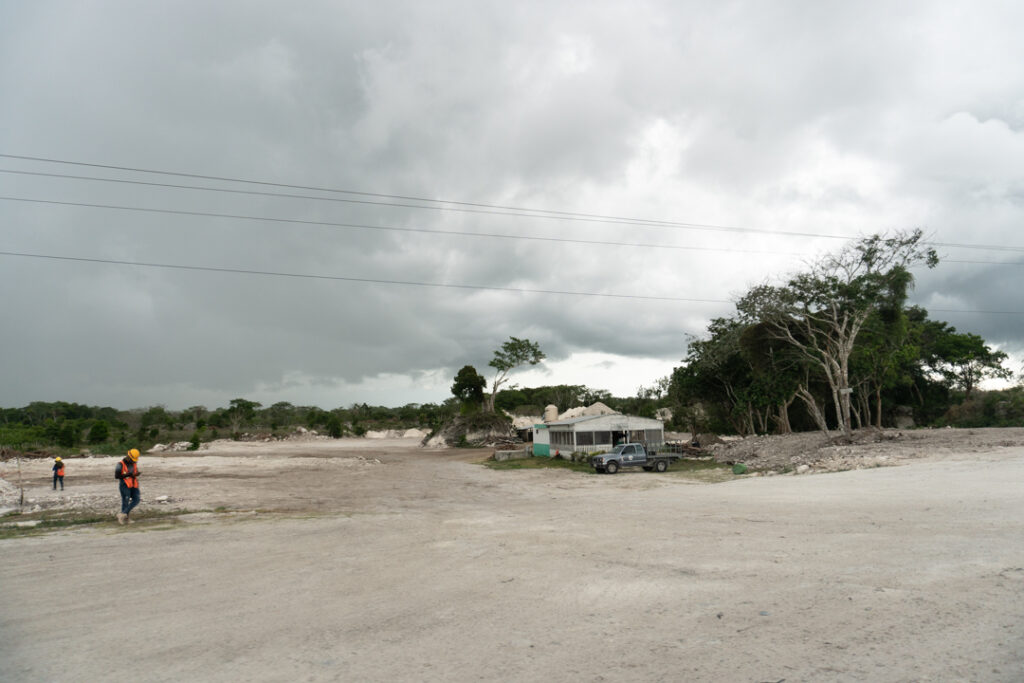
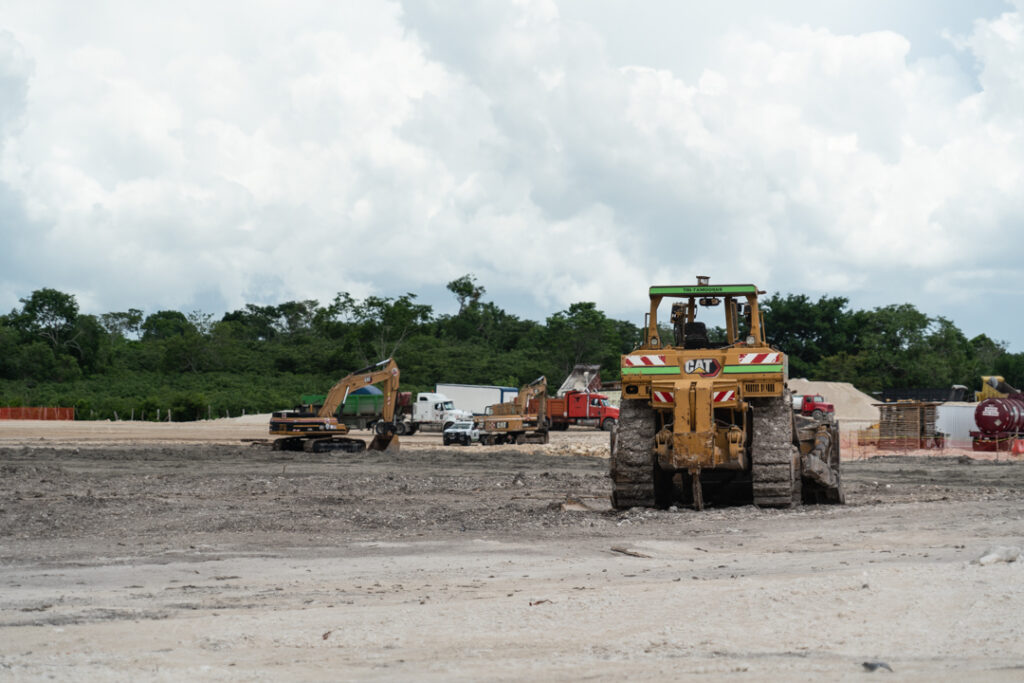


Blockades
“In 2021, 130 people united to set up a protest encampment here in the community,” explains the pastor. After three months blocking the construction, the ex-general director of FONATUR, Javier May Rodríguez, visited the inhabitants of Paraíso Nuevo.

“How is it possible that a train worth millions of pesos can pass through a town that is marginalized and without streets,” wonders Jiménez. In front of 200 community members, the ex-head of FONATUR promised a series of benefits: to pave the streets, provide solar panels, internet antennas, and improvements to the health clinic. They even promised a housing program, divided in three stages, the last of which was never fulfilled.
After this omission, 24 families were left without housing. In that moment, the officials of FONATUR, José Luis García Vela, infrastructure manager, and Mario Alberto Cárdenas Vera, analyst, refused to fulfill what May had promised. “After that, the idea emerged to again physically stop the construction, in November of 2022,” explained inhabitants of Paraíso Nuevo.
Two months passed without dialogue. The community members of the ejido denounced that FONATUR officials only showed their faces beneath pressure and threats from the mobilizations. “On January 9, 2023, the national guard, agents of the public prosecutor’s office, state police, and military arrived to evict the people,” recalls the pastor, regarding the operation during which he was detained and accused of organized crime.
“We were under an injunction,” claims Jiménez, who continues his legal process in freedom because FONATUR did not present evidence to support their legal complaint.
“They accused us of organized crime. They accused us of robbery. I am an evangelical pastor dedicated to preaching Jesus Christ. Far from motivating the people to do crime, I counsel them to do the right thing,” says the pastor in relation to the legal charges against him for his participation in the protests.
For her part, Rubí regrets that the division of the community has also manifested in the community fabric. She remembers that during the blockades, the majority of the people were united. However, once they began to distribute benefits, “the people who had already been given benefits, distanced themselves from the community, and joined the other side. Now, in meetings about drinking water, electricity, or any other issue related to the community, there is still friction,” she explains.
The pastor emphasizes that since the moment of his detention, the military, army, and national guard have their forces present in the community. “They watch over us so that nobody gets on the tracks,” he denounces.
Rubí is one of the women of Paraíso Nuevo who is raising her voice against the militarization of public space in her community. According to her, members of the army and national guard use drugs and alcohol in the parks and basketball courts of the community. In spite of the complaints, they claim that their superiors have relieved some personal. After the new ones arrive, they engage in the same type of conduct.
Military in Charge
On Monday, September 4, during the president’s morning news conference, it was announced that the control of the company Tren Maya Sociedad Anónima de Capital Variable (Tren Maya S.A de C.V.) would be transferred to the Secretariat of National Defense (SEDENA). It was also announced that General Óscar David Lozano Águila would become the general director. This transfer of power occurred after the resignation of Javier May, the head of FONATUR, the agency which had previously coordinated the project.
Since February 2023, Lozano had announced different actions to establish the company, Tren Maya S.A de C.V., with the intention of fulfilling the president’s promise since 2020 that SEDENA would manage and operate the project. “(General Lozano) will now formally do so by decision of the Secretary of Defense, Luis Cresencio Sandoval,” declared AMLO in September, along with announcing the signing of a decree to concretize the transfer of the megaproject to SEDENA, no later than December 31, 2023.
Cargo
For the conference on September 25, General Lozano reported the completion of 185 kilometers of the total 226 that make up Section 1 of the Maya Train, which runs from Palenque in Chiapas to Escárcega in Campeche.
The military highlighted that the construction of two important facilities are in the works for the loading and unloading of the trains in this section. “The first of them is an exchange terminal that will begin construction early next year in Palenque and will allow connection between the Interoceanic Corridor of the Isthmus of Tehuantepec (managed by the Secretary of the Navy) and the Maya Train,” emphasized the military officer.
He also added that in Escárcega, an operations yard was built to “be able to transport fuel, cement, steel, grain, perishable goods, including vehicles, among other items that will be transported through the train’s rail system.”
According to information from General Lozano at the beginning of 2023, the infrastructure of the Maya Train “will allow us to provide service to Petróleos Mexicanos, that Pemex will be the principal client of the Maya Train, because up to 80% of our capacity will be filled by Pemex.”
“It is not what the television says, nor the government,” reflects the pastor about who will benefit from the megaproject. “The government needs to see the southeast with different eyes, not with those of multimillionaire profits. They are imposing a project that is not even ours,” he claims, while waiting for the resolution of his own legal process for protesting against the megaproject in the Mexican southeast.
First Trip
During the first weekend in September of 2023, dozens of media outlets praised the start of the first trip of the Maya Train between sections 2 and 4. In a supervisory trip led by AMLO, the first train car traveled from the San Francisco station in Campeche, toward different stops and stations between the state of Yucatan and Quintana Roo.
According to Maite Ramos Gómez, director of Alstom Mexico, the business in charge of manufacturing and delivering 42 trains for the megaproject, the first trip of the Maya Train successfully passed the test by traveling 1000 kilometers through 14 stations. Ramos also informed that the model of the train uses diesel, contrasting with the official discourse which had insured that the energy used to move the train would be electric.
According to government officials, the inauguration of the megaproject is planned for December 21, 2023. In total, it will travel 1,545 kilometers through the states of Chiapas, Tabasco, Campeche, Yucatan, and Quintana Roo.
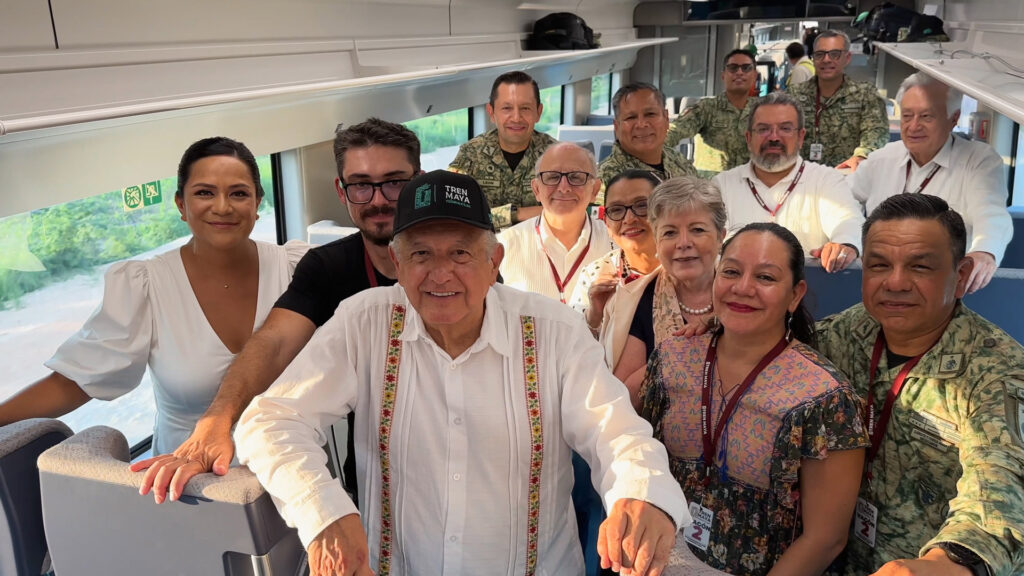
Along with AMLO, military officials and members of his cabinet, like the head of SEMARNAT, Maria Luisa Albores, were present to celebrate the first trip on the train.

